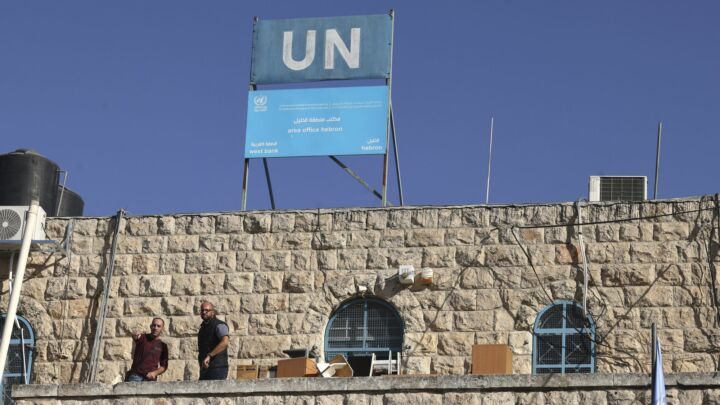Hearts, minds and missiles
Was the USA's 'Shock and Awe' campaign aimed at Iraqis, or the US public?

Want to read spiked ad-free? Become a spiked supporter.
During the weeks leading up to the war in Iraq, the media drew everyone’s attention to a promised sound and light show, the likes of which the world had never seen before.
Reports, fed to the networks largely by the US Department of Defence, that the invasion would begin with planes and ships launching between 300 and 400 cruise missiles each day heightened the anticipation. Like children awaiting the fourth of July, people waited to see Baghdad lit up like a roman candle as bombs with names like ‘Mother of all Bombs’ and ‘Bunker-Buster’ smashed Saddam’s regime to smithereens.
In the first days of the war, it appeared that things were not going according to plan. The initial bombing strikes produced far less than the anticipated thunder, and the televised feed from 24-hour ‘breaking news’ channels like CNN and al-Jazeera didn’t show many fireworks. Audiences at home and abroad began to voice disappointment, some even expressing the suspicion that plans had gone seriously awry.
Events never did build up to the expected theatrical extravaganza nor did they, as some suggested, disintegrate into an epic remake of Vietnam. Now, as the war comes to its untidy end and the public’s attention begins to move on, I’m left wondering what all the media hype was about.
In retrospect, I have my doubts that ‘Shock and Awe’, as the Pentagon dubbed the military strategy, was targeted at the Iraqis so much as at the American people. I suspect that it had less to do with astonishing the enemy than it did with swaying the hearts and minds of the public back home.
Shock and awe is less about destruction than about a display of power and might, combining military force with psychological warfare in a concerted effort to overwhelm and intimidate. The theory behind it, as outlined in a 1996 report by the Pentagon-run National Defense University, is ‘to seize control of the environment and so overload an adversary’s perceptions and understanding of events that the enemy would be…rendered totally impotent and vulnerable to our actions’. Shock and awe, in the words of its originator, Harlan Ullman, is designed to control people ‘physically, emotionally and psychologically’.
While this may have been the motive behind the bombings, the leaflet drops, and the early drive-throughs of US tanks in Baghdad, it may also have been the intent behind much of what was happening back home.
Shock and awe is essentially a propaganda campaign. What happened before the war began and what is happening now make sense if one begins to think about how the American psy-ops policy is being played out on its own people.
First came the shock waves of fear, emanating from images of the Twin Towers, that the US could be hit by chemical, biological and nuclear weapons. Each time the Alert Level was raised, always with dramatic fanfare, to Orange, a media-inspired panic swept through the nation.
When the US Department of Homeland Security advised Americans to make an emergency kit for use during a possible attack, many anxious citizens rushed out to buy up all the duct tape local hardware stores could supply. The alerts, and this talk about preparing for the worst, gave Americans the sense that they were under attack. It was designed to create a wartime mentality.
The conflict against Iraq could only be justified in terms of this fear alone; so, the ability to think critically had to be curtailed. With its citizens psychologically set for war, the reports of the UN inspectors, and the perspectives of other nations, including Canada, became irrelevant. Minds in America, like tabulae rasa, were encouraged to believe anything that would bolster feelings of security and comfort.
Now, with a Coalition victory pretty much assured, there is an attempt to fill these minds to the brim with unconditional awe. According to First Lady Laura Bush: ‘We (Americans) can feel sadness, anger and fear, yet out of those emotions rises courage, faith and optimism.’
Throughout this hi-tech war, what the US military was demonstrating was the vastness of its superiority at conventional warfare. And, all the time the guns were firing in Iraq, Americans were being told that they could deal with the stress of war and come through adversity, not only unscathed, but actually feeling stronger and hardier than they had ever felt before. As the White House and organisations such as the American Psychological Association kept telling them – they had resilience!
That’s the new buzzword. Just as ‘9-11’ served as the ‘shock word’ on the homefront, ‘resilience’ serves now as the ‘awe word’.
I don’t think that the Iraq war is another ‘wag-the-dog’, but I do think that, while government sources and broadcasters have been distracting attention to the so-called shock and awe of bombs dropped on Baghdad, the real mind control job was just beginning in the American homeland. Whether this strategy succeeds, of course, is another matter. As the BBC keeps saying these days: ‘The propaganda war has only just begun.’
Dr Tana Dineen is the author of Manufacturing Victims: What the Psychology Industry is Doing to People, Constable-Robinson (UK) 1999, Robert-Davies (North America) 1996, 2001 (buy this book from Amazon UK or Amazon USA) and a frequent columnist to Canadian newspapers including the Ottawa Citizen. A practicing psychologist for three decades, and now a brutal critic of her own profession, she has been dubbed ‘The Dissident Psychologist’ by the North American media.
Read on:
spiked-issue: War on Iraq
Celebrate 25 years of spiked!
A media ecosystem dominated by a handful of billionaire owners, bad actors spreading disinformation online and the rich and powerful trying to stop us publishing stories. But we have you on our side. help to fund our journalism and those who choose All-access digital enjoy exclusive extras:
- Unlimited articles in our app and ad-free reading on all devices
- Exclusive newsletter and far fewer asks for support
- Full access to the Guardian Feast app
If you can, please support us on a monthly basis and make a big impact in support of open, independent journalism. Thank you.






Comments
Want to join the conversation?
Only spiked supporters and patrons, who donate regularly to us, can comment on our articles.